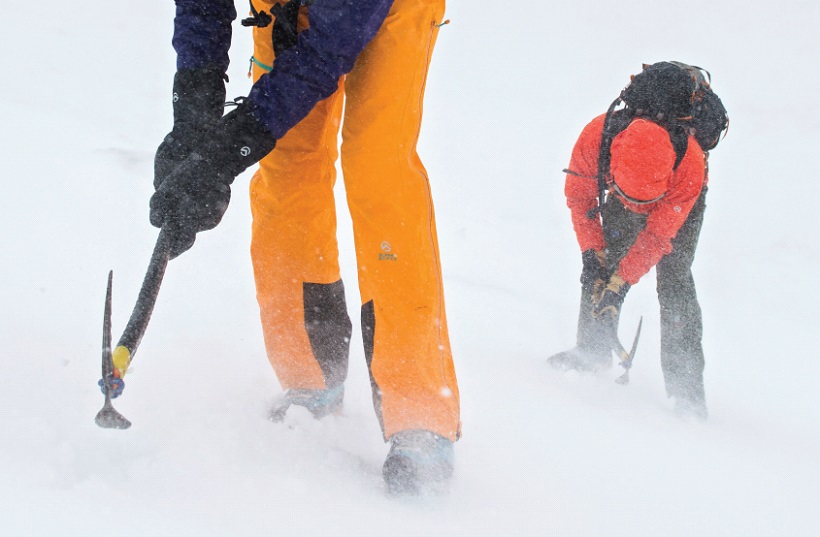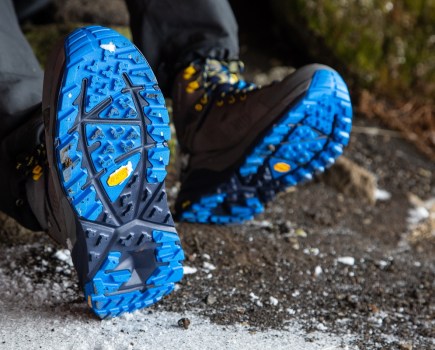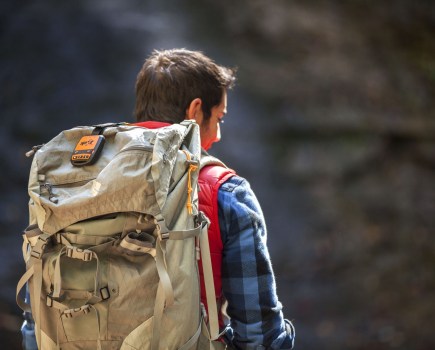This article on how to use an ice axe was first published in 2016.
Your ice axe is a key tool in effective and efficient movement. It gives stability and security with a range of techniques in skilled and practised hands. Let’s take a further look at how to use an ice axe to keep you confident and safe.
A good piece of advice commonly given is: “In descent always approach an unknown slope with your axe in hand.” In the UK, the favoured default position in use as a movement aid is to hold the axe by the head, in the uphill hand, with the pick facing back.
Techniques for walking with an ice axe
Traverses and diagonal ascent/descent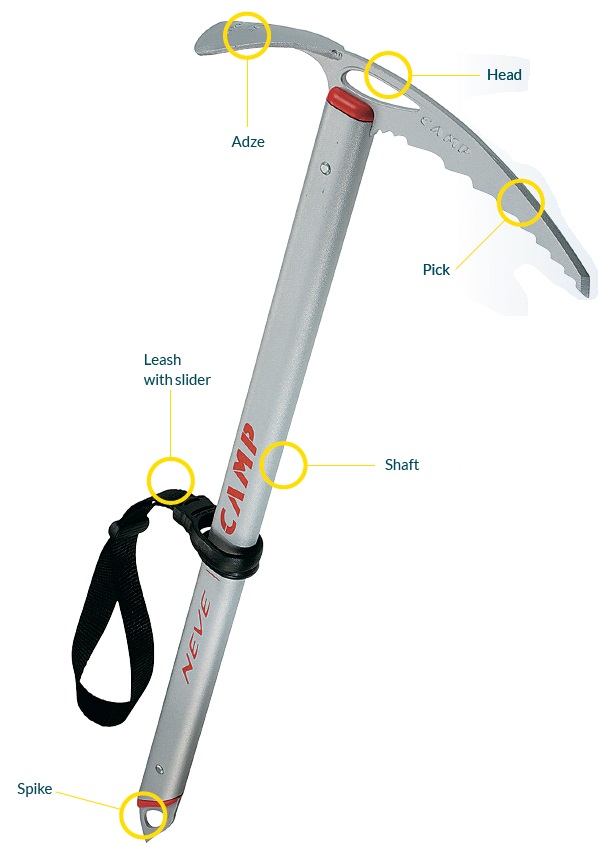
- Axe in uphill hand
- Stable position – axe in line with upper leg, upper foot ahead of lower foot
- Move axe just ahead of upper foot then step lower foot first
- 100%-80 % pressure/body weight shared between feet; 0-20 % on axe
- Change direction, change hands
- Options to change direction facing in or out
- There are a variety of hand positions and axe orientations – pick forward, pick back, high dagger, low dagger top, middle and bottom of shaft
In steeper terrain, on harder slopes and windier conditions, move in a tripod fashion from a stable position to a stable position. Look for rhythm: ie. axe, step, step; axe, step, step or axe, kick, kick; axe kick, kick.
Direct ascent
- Axe in favoured hand
- Move axe then feet
- Remember rhythm
- One axe movement and 2-4 footsteps
As in traverses, there are a variety of holding options depending on terrain demands.
Descent facing in
- Generally a high or low dagger grip (the hand grasping the head of the axe with the pick forward and the shaft hanging down) or high shaft grip
- Move axe below hips
- Two or more kicks to bring torso level with axe before repeating.
Descent facing out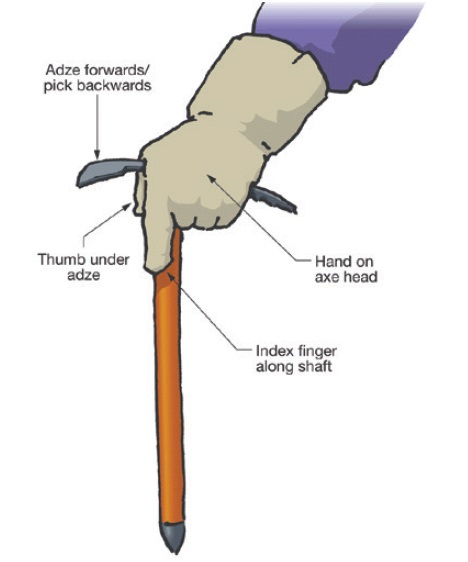
- Axe in preferred hand
Horizontal traversing
- Axe in favoured hand or try hand in direction of travel
- From a wide stable tripod stance, move axe first then feet
- On softer snow, take wider steps
- Remember rhythm – axe, step, step.
Cutting steps
With the speed and ease of attachment of modern crampons this is an art that is practiced less and less. But what if you or someone in your party have forgotten those crampons, have had one fall off down a slope, broken them, made a poor judgment call and end up on a firm patch of snow or are faced with a short patch of hard snow?
All steps should be horizontal/perpendicular to the fall line (the direct line down the hill). When slashing, if it is taking more than two or three slashes to cut a step, you will probably be better off with crampons on if you have them. When chopping, always chop progressively away from the first chop. You should only need 3-4. It’s worth considering putting on the axe leash.
Slash steps in diagonal ascent
- Axe in upper hand
- Swing from shoulder
- Aim to cut a horizontal slash step that overlaps your forward boot and is about a boot width above, ie. small steps
- One step cut at a time
- Step up or step through
- Big ledge for direction changes
Chopping steps – traversing
- You can chop one or two steps at a time, or even chop big bucket-shaped steps with both hands.
Slash in descent
- Axe in downhill hand
- Upper hand rests on upper knee
- Bend at knees and hips to reach down slope
- Swing from shoulder
- Develop skill to cut horizontal steps in any downward direction i.e. slightly ahead, behind or directly down.
Ice axe arrests
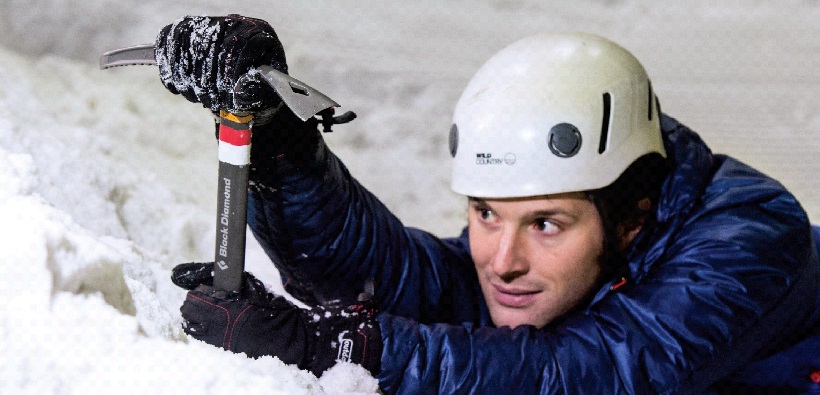
Practice all the techniques described in this section, get some more coaching in movement and make the right decisions and hopefully you will never need to self-arrest. It is better to spend time on good movement than it is self-arresting. Remain tuned in to the environment.
Things that have caused trips and slips include:
- Gusts of wind
- Turning around from front-pointing in descent to facing out
- Tripping over baggy trousers
- Tripping over feet ie. not keeping feet apart
- Tripping over terrain features
- Changing slipperiness of terrain when no crampons were worn
- Tiredness/fatigue
- Poor boot or crampon technique
- Poor navigation, ie. walking onto a slope in poor visibility and unprepared
- Being too relaxed.
The technique of a basic self-belay is generally well understood. In a slip, trip or gust of wind, one could fall in any direction; the bottom line is: do your best to avoid it becoming a slide.
If you trip or get blown over, do anything you can to stop immediately, simply get any part of the axe in the snow and hold on tight, trying to get both hands holding on (see photograph above).
Practicing ice axe arrests
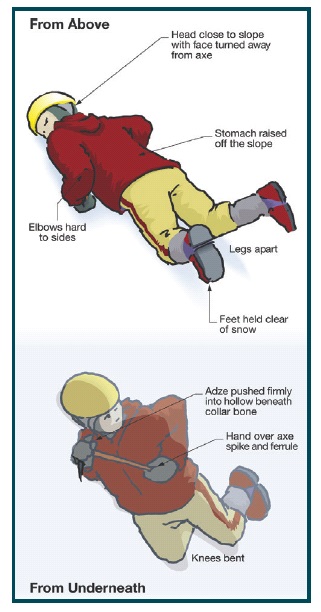 When practising arrests, make it reasonably realistic and consider wearing your rucksack. Choose a safe slope area with a safe run-out to fl at ground, and watch out for shallow/hidden rocks. Don’t practise on bullet-hard névé! Ideally, put on old waterproofs. Then remove your crampons and put on a helmet. Once you come to a stop, it is important to kick your feet into the slope before you stand up. The basic braking position is feet first on your front (see illustration, right). All the other techniques should get you into this position. The pressure of your bodyweight on the axe head keeps the pick in the snow, and it is this that provides the brake.
When practising arrests, make it reasonably realistic and consider wearing your rucksack. Choose a safe slope area with a safe run-out to fl at ground, and watch out for shallow/hidden rocks. Don’t practise on bullet-hard névé! Ideally, put on old waterproofs. Then remove your crampons and put on a helmet. Once you come to a stop, it is important to kick your feet into the slope before you stand up. The basic braking position is feet first on your front (see illustration, right). All the other techniques should get you into this position. The pressure of your bodyweight on the axe head keeps the pick in the snow, and it is this that provides the brake.
Techniques
[1] Feet first on front
- Hand holding axe head pulled to same shoulder
- Lower hand covering spike
- Head looking down shaft to spike hand
- Squeeze body and pick into snow
- Bum up can help add pressure to pick
- Knees apart
- Feet up – especially important if needing to do this for real when wearing crampons!
[2] Feet first on back
- Place axe in position as stated above
- Roll to same side that the head of your axe is on
- You should now be in the basic braking position.
With the next two, there is an off stage where the axe head needs to be dragged/brought back under control at the shoulder. This needs to be done quickly then pressure reapplied.
[3] Head first on front
- Both hands on – one on axe head one on spike
- Reach out same side as axe head hand as extension to shoulder
- Drag the pick in the snow and begin to pivot around it
- Push hips away from axe – make a banana shape with your body to help you pivot
• Continue with self-arrest as above.
[4] Head first on back
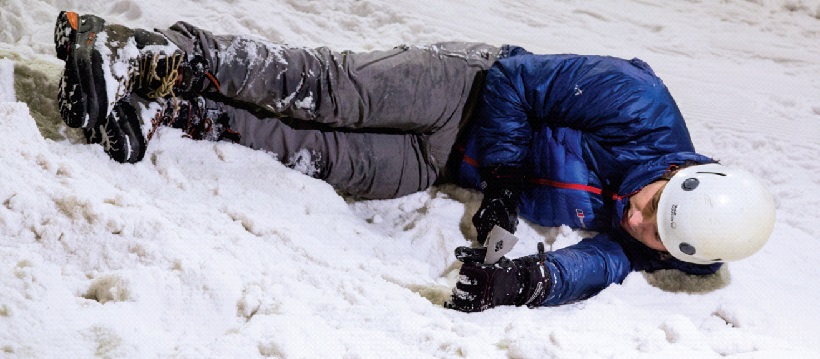
- Both hands on – one on axe head one on spike
- Reach up and out level with hips on same side as handholding axe head
- Your body should be a banana shape curved around the axe head as the pick drags in the snow
- Try and roll onto hip to aid rotation (see photograph, right)
- Pull legs away and down slope
- Continue with either feet first on front or feet first on
back.
[5] Tumbling fall
When you’re practising, it’s better to log-roll your way into this one.
- Assume a star shape with your arms and legs, with the axe held firmly in one hand and well away from your body.
- Once stabilised, work out which of the above positions you’ve ended up in and perform the appropriate manoeuvre to end up in the basic braking position.
Learn from the experts
Like most practical outdoor skills, ice axe and crampon technique is always best learned in a practical environment. Based in the Cairngorms National Park, Glenmore Lodge National Outdoor Training Centre offers fantastic training in winter skills at all levels. Find out more and book your course by calling 01479 861 256 or visit: glenmorelodge.org.uk

